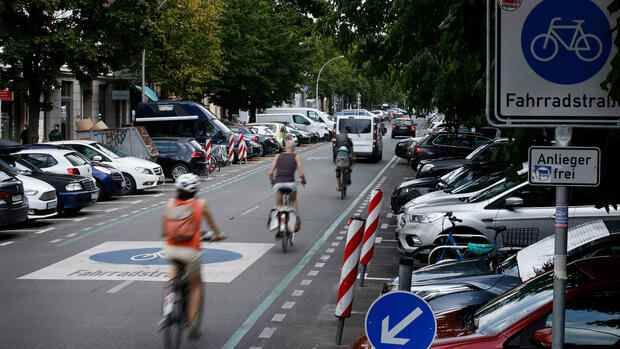Berlin The program for the road and transport congress could hardly be more political: When civil engineers from industry, transport planners from science and experts from the administrations of the federal, state and local authorities meet in Dortmund at the beginning of October, then it doesn’t work about new gravel mixtures for concrete and other technical questions – as was often the case in the past. It’s about reducing the space for the car – in favor of pedestrians, cyclists, buses and trains.
The members of the inviting Research Society for Roads and Transport will talk about “Traffic planning on the way to climate-neutral mobility”. They even open a climate forum. “We are creating the basis for the traffic of tomorrow,” says that company.
In fact, the experts have been setting the rules of the game on the streets for decades, unobserved by the public, dividing the space between cars (more and more), cyclists (two meters in both directions) and pedestrians (180 centimetres), deciding how long a traffic light should shine green, and remind them to switch it on at night if possible.
And now, after almost 100 years, for the first time the car is no longer the measure of all things at the Research Society for Roads and Transport (FGSV). In the privately organized club, the starting signal could be given in Dortmund so that the municipalities “recapture” public space for the people, as the German Association of Cities demands. Critics of the FGSV might be surprised.
Top jobs of the day
Find the best jobs now and
be notified by email.
“Higher, faster, further” and “right of way for the car” have been the mottos so far, explains Professor Oliver Schwedes from the Technical University of Berlin. When cars got bigger, streets and parking lots had to be wider as well.
>>> Read here: The Great Robotaxis Race: China vs. USA
After all, the FGSV was founded in 1924 to develop suitable routes for automobiles. “The club comes from another time,” criticizes traffic planner Schwedes. He calls for parliamentary control because mobility is undergoing a transformation and things are being rethought.
The FGSV sets standards and norms. When asked, the city of Cologne said that the city “naturally” applies the technical regulations. In Leipzig, the spokeswoman said the city only deviated “in justified exceptional cases”. And the city-state of Berlin finds itself in court because the so-called pop-up bike lanes painted on the streets in 30 km/h zones during the Corona period contradict the “recommendations for cycling facilities”.
The “green leaf” of the Federal Minister of Transport
The technical regulations receive an introductory “green sheet” from the Federal Ministry of Transport. It looks like the green light: The rules are then binding on motorways and federal roads, and the Federal Minister strongly recommends that the federal states also adhere to the specifications for state and municipal roads.
But now the FGSV is reacting – to criticism and also to the climate targets set by law. “Something has to happen, and something will happen,” says Professor Jürgen Gerlach, Professor of Transport Planning at the University of Wuppertal.
The civil engineer and traffic planner not only leads the FGSV working group on traffic planning, in which politically explosive issues are negotiated. Since the beginning of the year he has also headed an ad hoc group. She should find out how the existing regulations can be changed quickly in order to be able to do more to protect the climate on the streets.
The result sounds like a small revolution. The group has divided all regulations into three categories. First: those who continue to be good and right. This includes the recommendation to plan traffic regionally and nationally. After all, most of the emissions come from trips of more than 20 kilometers. “Fewer trips, shorter routes, more public and rail transport” is the order of the day, says Gerlach.
Quality standards in focus
The second category includes rules intended to receive “additional notes”. It’s about the “Manual for the dimensioning of road traffic systems”. It defines the quality standards that traffic lights, priority signs or a motorway exit must have.
Adapting this has always taken many years. Now something new should apply in the short term, for example the FGSV wants to extend green phases for cyclists and pedestrians and introduce green waves for cyclists. “It’s a paradigm shift,” says Gerlach.
The third category includes rules that need revision. It’s about the controversial parking space in the city. Does it have to grow with the ever larger cars? Other criteria come into focus: more greenery, more trees as temperature regulators in the city, water storage in times of drought and heavy rain.
Because time is short, the research company wants to publish “correction sheets” first. This enables changes, later the climate-friendly regulations will follow. “We have to rebuild the street space, not in 30 years, but now,” warns Gerlach. If in doubt, drivers would have to “walk ten minutes” from the parking lot to their destination.
>>> Also read: The federal government waives billions from the truck toll
It is also about a fundamental question: Why does the bike always drive on the right and the car in the middle? Why not be safe in the middle like Barcelona in Spain on bike superhighways?
The experts are also discussing inner-city cargo bike routes and thus more space, which the General German Bicycle Club, for example, has been demanding for a long time. Gerlach admits that “you can’t get any further” with the two-meter-wide cycle paths that have been set up so far.
After the congress, the FGSV wants to publish parts of the climate debates online – and then discuss them with interest groups. “We want to enter into dialogue,” assures Gerlach. At the same time, he made it clear that the FGSV only provides the instruments. “Politics and society must decide.”
More: “Cleansing thunderstorm”: Habeck and Wissing argue about CO2 emissions in traffic
